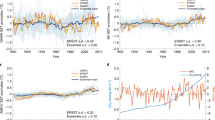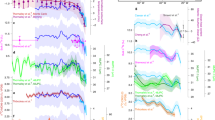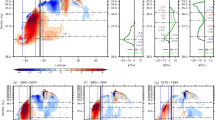Abstract
Possible changes in Atlantic meridional overturning circulation (AMOC) provide a key source of uncertainty regarding future climate change. Maps of temperature trends over the twentieth century show a conspicuous region of cooling in the northern Atlantic. Here we present multiple lines of evidence suggesting that this cooling may be due to a reduction in the AMOC over the twentieth century and particularly after 1970. Since 1990 the AMOC seems to have partly recovered. This time evolution is consistently suggested by an AMOC index based on sea surface temperatures, by the hemispheric temperature difference, by coral-based proxies and by oceanic measurements. We discuss a possible contribution of the melting of the Greenland Ice Sheet to the slowdown. Using a multi-proxy temperature reconstruction for the AMOC index suggests that the AMOC weakness after 1975 is an unprecedented event in the past millennium (p > 0.99). Further melting of Greenland in the coming decades could contribute to further weakening of the AMOC.
This is a preview of subscription content, access via your institution
Access options
Subscribe to this journal
Receive 12 print issues and online access
$209.00 per year
only $17.42 per issue
Buy this article
- Purchase on Springer Link
- Instant access to full article PDF
Prices may be subject to local taxes which are calculated during checkout






Similar content being viewed by others
Change history
03 September 2015
In the version of this Article originally published, in Fig. 1 the data plotted were for the calendar month of December and not the annual mean data. This has been replaced with a new global temperature trend map for annual mean data, in which (due to the reduced variability of annual as compared with monthly data) the cooling patch in the subpolar North Atlantic stands out even more. The first sentence of the caption for Fig. 1 has been amended to: 'Linear trends of annual surface temperature since AD 1901'. None of the conclusions in the Article are affected by this error.
References
Stouffer, R. et al. Investigating the causes of the response of the thermohaline circulation to past and future climate changes. J. Clim. 19, 1365–1387 (2006).
Latif, M. et al. Reconstructing, monitoring, and predicting multidecadal-scale changes in the North Atlantic thermohaline circulation with sea surface temperature. J. Clim. 17, 1605–1614 (2004).
Dima, M. & Lohmann, G. Evidence for two distinct modes of large-scale ocean circulation changes over the last century. J. Clim. 23, 5–16 (2010).
Thompson, D. W. J., Wallace, J. M., Kennedy, J. J. & Jones, P. D. An abrupt drop in Northern Hemisphere sea surface temperature around 1970. Nature 467, 444–447 (2010).
Feulner, G., Rahmstorf, S., Levermann, A. & Volkwardt, S. On the origin of the surface air temperature difference between the hemispheres in Earth’s present-day climate. J. Clim. 26, 7136–7150 (2013).
Drijfhout, S., van Oldenborgh, G. J. & Cimatoribus, A. Is a decline of AMOC causing the warming hole above the North Atlantic in observed and modeled warming patterns? J. Clim. 25, 8373–8379 (2012).
Booth, B. B. B., Dunstone, N. J., Halloran, P. R., Andrews, T. & Bellouin, N. Aerosols implicated as a prime driver of twentieth-century North Atlantic climate variability. Nature 484, 228–232 (2012).
Zhang, R. et al. Have aerosols caused the observed Atlantic multidecadal variability? J. Atmos. Sci. 70, 1135–1144 (2013).
Terray, L. Evidence for multiple drivers of North Atlantic multi-decadal climate variability. Geophys. Res. Lett. 39, L19712 (2012).
Roberts, C. D., Garry, F. K. & Jackson, L. C. A multimodel study of sea surface temperature and subsurface density fingerprints of the Atlantic meridional overturning circulation. J. Clim. 26, 9155–9174 (2013).
Jungclaus, J. H. et al. Characteristics of the ocean simulations in the Max Planck Institute Ocean Model (MPIOM) the ocean component of the MPI-Earth system model. J. Adv. Model. Earth Syst. 5, 422–446 (2013).
Mann, M. E. et al. Proxy-based reconstructions of hemispheric and global surface temperature variations over the past two millennia. Proc. Natl Acad. Sci. USA 105, 13252–13257 (2008).
Mann, M. E. et al. Global signatures and dynamical origins of the Little Ice Age and Medieval Climate Anomaly. Science 326, 1256–1260 (2009).
Wanamaker, A. et al. Surface changes in the North Atlantic meridional overturning circulation during the last millennium. Nature Commun. 3, 899 (2012).
Crowley, T. J. Causes of climate change over the past 1000 years. Science 289, 270–277 (2000).
Shindell, D. T., Schmidt, G. A., Miller, R. L. & Mann, M. E. Volcanic and solar forcing of climate change during the preindustrial era. J. Clim. 16, 4094–4107 (2003).
Feulner, G. Are the most recent estimates for Maunder Minimum solar irradiance in agreement with temperature reconstructions? Geophys. Res. Lett. 38, L16706 (2011).
PAGES 2k Consortium Continental-scale temperature variability during the past two millennia. Nature Geosci. 6, 339–346 (2013).
Willis, J. Can in situ floats and satellite altimeters detect long-term changes in Atlantic Ocean overturning? Geophys. Res. Lett. 37, L06602 (2010).
Moffa-Sanchez, P., Born, A., Hall, I. R., Thornalley, D. J. R. & Barker, S. Solar forcing of North Atlantic surface temperature and salinity over the past millennium. Nature Geosci. 7, 275–278 (2014).
Miettinen, A., Divine, D., Koc, N., Godtliebsen, F. & Hall, I. R. Multicentennial variability of the sea surface temperature gradient across the subpolar North Atlantic over the last 2.8 kyr. J. Clim. 25, 4205–4219 (2012).
Delworth, T. L. & Mann, M. E. Observed and simulated multidecadal variability in the Northern Hemisphere. Clim. Dynam. 16, 661–676 (2000).
Chambers, D. P., Merrifield, M. A. & Nerem, R. S. Is there a 60-year oscillation in global mean sea level? Geophys. Res. Lett. 39, L18607 (2012).
Tung, K. & Zhou, J. Using data to attribute episodes of warming and cooling in instrumental records. Proc. Natl Acad. Sci. USA 110, 2058–2063 (2013).
Sherwood, O. A., Lehmann, M. F., Schubert, C. J., Scott, D. B. & McCarthy, M. D. Nutrient regime shift in the western North Atlantic indicated by compound-specific delta N-15 of deep-sea gorgonian corals. Proc. Natl Acad. Sci. USA 108, 1011–1015 (2011).
Bryden, H. L., Longworth, H. R. & Cunningham, S. A. Slowing of the Atlantic meridional overturning circulation at 25° N. Nature 438, 655–657 (2005).
Kanzow, T. et al. Seasonal variability of the Atlantic Meridional overturning circulation at 26.5° N. J. Clim. 23, 5678–5698 (2010).
Smeed, D. A. et al. Observed decline of the Atlantic meridional overturning circulation 2004–2012. Ocean Sci. 10, 29–38 (2014).
Curry, R. & Mauritzen, C. Dilution of the northern North Atlantic Ocean in recent decades. Science 308, 1772–1774 (2005).
Belkin, I. M., Levitus, S., Antonov, J. & Malmberg, S-A. “Great Salinity Anomalies” in the North Atlantic. Prog. Oceanogr. 41, 1–68 (1998).
Dickson, R. R., Meincke, J., Malmberg, S. A. & Lee, A. J. The “Great Salinity Anomaly” in the northern North Atlantic, 1968–82. Prog. Oceanogr 20, 103–151 (1988).
Peterson, B. J. et al. Increasing river discharge to the Arctic Ocean. Science 298, 2171–2173 (2002).
Box, J. & Colgan, W. Greenland Ice Sheet mass balance reconstruction. Part III: Marine ice loss and total mass balance (1840–2010). J. Clim. 26, 6990–7002 (2013).
Rye, C. et al. Rapid sea-level rise along the Antarctic margins in response to increased glacial discharge. Nature Geosci. 7, 732–735 (2014).
Lazier, J. R. N. Oceanographic conditions at Ocean Weather Ship Bravo, 1964–74. Atmos-Ocean 18, 227–238 (1980).
Kuhlbrodt, T., Titz, S., Feudel, U. & Rahmstorf, S. A simple model of seasonal open ocean convection. Part II: Labrador Sea stability and stochastic forcing. Ocean Dynam. 52, 36–49 (2001).
Gelderloos, R., Straneo, F. & Katsman, C. A. Mechanisms behind the temporary shutdown of deep convection in the Labrador Sea: Lessons from the great salinity anomaly years 1968–71. J. Clim. 25, 6743–6755 (2012).
Robson, J. I., Sutton, R. T. & Smith, D. M. Initialized decadal predictions of the rapid warming of the North Atlantic Ocean in the mid 1990s. Geophys. Res. Lett. 39, L19713 (2012).
Robson, J., Hodson, D., Hawkins, E. & Sutton, R. Atlantic overturning in decline? Nature Geosci. 7, 2–3 (2014).
Lozier, M. S., Roussenov, V., Reed, M. S. C. & Williams, R. G. Opposing decadal changes for the North Atlantic meridional overturning circulation. Nature Geosci. 3, 728–734 (2010).
Zhang, R. Coherent surface-subsurface fingerprint of the Atlantic meridional overturning circulation. Geophys. Res. Lett. 35, L20705 (2008).
Hofmann, M. & Rahmstorf, S. On the stability of the Atlantic meridional overturning circulation. Proc. Natl Acad. Sci. USA 106, 20584–20589 (2009).
Weaver, A. J. et al. Stability of the Atlantic meridional overturning circulation: A model intercomparison. Geophys. Res. Lett. 39, L20709 (2012).
Nghiem, S. V. et al. The extreme melt across the Greenland Ice Sheet in 2012. Geophys. Res. Lett. 39, L20502 (2012).
Bamber, J., van den Broeke, M., Ettema, J., Lenaerts, J. & Rignot, E. Recent large increases in freshwater fluxes from Greenland into the North Atlantic. Geophys. Res. Lett. 39, L19501 (2012).
Rahmstorf, S. Shifting seas in the greenhouse? Nature 399, 523–524 (1999).
Wood, R. A., Keen, A. B., Mitchell, J. F. B. & Gregory, J. M. Changing spatial structure of the thermohaline circulation in response to atmospheric CO2 forcing in a climate model. Nature 399, 572–575 (1999).
Hansen, J., Ruedy, R., Glascoe, J. & Sato, M. GISS analysis of surface temperature change. J. Geophys. Res. 104, 30997–31022 (1999).
Morice, C. P., Kennedy, J. J., Rayner, N. A. & Jones, P. D. Quantifying uncertainties in global and regional temperature change using an ensemble of observational estimates: The HadCRUT4 data set. J. Geophys. Res. 117, D08101 (2012).
Mann, M. E. & Lees, J. M. Robust estimation of background noise and signal detection in climatic time series. Climatic Change 33, 409–445 (1996).
Huck, T., Colin de Verdiere, A., Estrade, P. & Schopp, R. Low-frequency variations of the large-scale ocean circulation and heat transport in the North Atlantic from 1955–1998 in situ temperature and salinity data. Geophys. Res. Lett. 35, L23613 (2008).
Acknowledgements
We thank O. Sherwood for providing coral data. M.E.M. acknowledges support for this work from the ATM program of the National Science Foundation (grant ATM-0902133).
Author information
Authors and Affiliations
Contributions
S.Rahmstorf conceived and designed the research and wrote the paper, E.J.S., S.Rutherford, A.R. and G.F. performed the research, M.E.M. and J.E.B. contributed materials/analysis tools and co-wrote the paper.
Corresponding author
Ethics declarations
Competing interests
The authors declare no competing financial interests.
Supplementary information
Rights and permissions
About this article
Cite this article
Rahmstorf, S., Box, J., Feulner, G. et al. Exceptional twentieth-century slowdown in Atlantic Ocean overturning circulation. Nature Clim Change 5, 475–480 (2015). https://doi.org/10.1038/nclimate2554
Received:
Accepted:
Published:
Issue Date:
DOI: https://doi.org/10.1038/nclimate2554
This article is cited by
-
Reply to: Evidence lacking for a pending collapse of the Atlantic Meridional Overturning Circulation
Nature Climate Change (2024)
-
Rapid decrease of the Labrador Sea’s influence on black spruce ecosystems with distance inland
Communications Earth & Environment (2024)
-
Ubiquitous acceleration in Greenland Ice Sheet calving from 1985 to 2022
Nature (2024)
-
Increased Asian aerosols drive a slowdown of Atlantic Meridional Overturning Circulation
Nature Communications (2024)
-
Evidence lacking for a pending collapse of the Atlantic Meridional Overturning Circulation
Nature Climate Change (2024)



